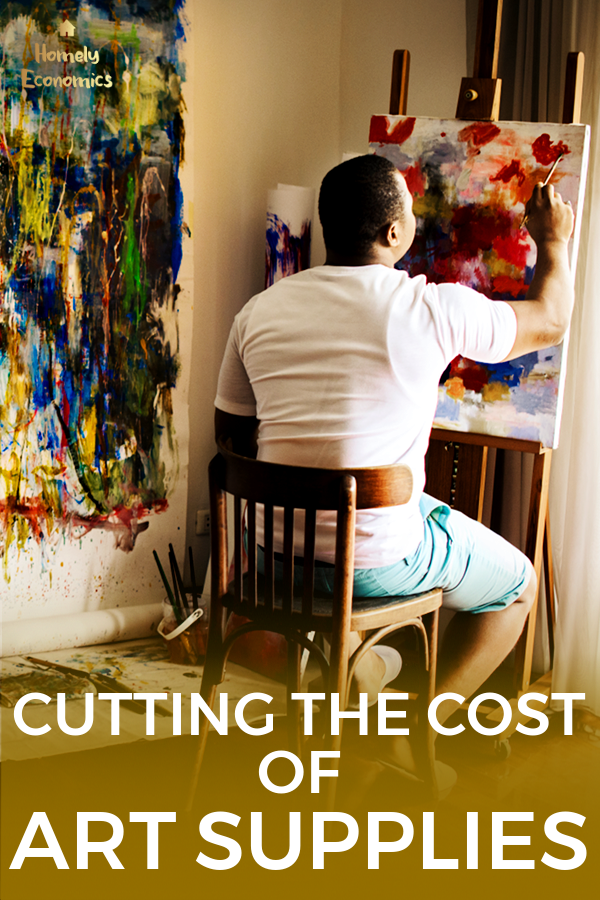This post contains affiliate links, marked by *
How can you cut the cost of art supplies?
The cost of art supplies goes up and up over the years. Unfortunately, it seems as though we’ll always cough up money for materials, art supplies and ways to promote our work, regardless of whether or not we’ll make any profit from our work.
That’s because of love – we love what we do, but that certainly doesn’t mean we don’t deserve to earn a living from it.
If your raw materials are ridiculously expensive, the retail price of your finished artwork must be high enough for you to cover your costs and make a profit (and pay for your time). The rules of business don’t cease to apply just because it’s art you’re making.
So what can you do to cut the cost of your art supplies?
Ditch tradition
Really, the biggest money-waster is tradition. Do you really need to work in the same materials that the ‘old masters’ used, or is that just something that will make you feel better about yourself and your work?
Manufacturers know that slapping the name of a famous artist on some old tat is a great money-spinner, and not just for art.
I never work on canvas anymore because I hate the texture and the way it disrupts my fine detail. I prefer to prime sheets of thick watercolour paper and blocks of MDF – I’ve found what I like, and I make work I like.
So if you’re stuck on working in ways that you think are best simply because they’re traditional, you’ll be missing out on the staggering leaps that 21st century art has made. I don’t think anyone can afford to do that.
Make it yourself
Gosh, the internet is your friend when it comes to making DIY versions of nearly everything. You just need to put in the time to dig for it! You’ll probably find that by taking the time to learn how to fake your own block printing ink, oil paints*, or mixed media*, you’ll enjoy the process more than if you’d bought something off-the-shelf.
Embrace a new medium
Ok, I didn’t do well with this advice, as I jumped into the tumble dryer of life not long afterwards and didn’t make much of any work… but hey, I never forgot it.
Since then, I set up and then sold a ceramics workshop (see below), then moved on to sewing and textiles, then went right back to painting. It kinda led to the jack-of-all-(art)-trades training that’s allowed me to live off of two days a week as an art technician and has allowed me to develop my practice.
Turns out that I’m a better painter than I ever was a potter!
Use gift cards
Big art stores often issue gift cards which you can buy at a discount. I use gift card marketplaces to keep my eyes peeled for these.
Buy second-hand
A low point for me became a high point for someone else 10 years ago – I sold the entire contents of my ceramics studio on eBay for a ridiculous £100.
It was a distress sale forced by a divorce and house move, and I didn’t know where I was going to live as a newly single parent, far less where I would move the kiln, slab roller, wheel, jigger jolley, moulds, clay, glazes… you get the picture.
Yes, it was gutting, but that was life back then. I needed it gone, and another artist got an amazing deal.
Art schools, colleges and universities can often dispose of unneeded machinery on eBay* (that’s where I found much of my studio equipment in the first place), so set up a custom search in your area and see what comes up.
Think before you throw it out
Is it really too old? I’ve still got oil paints that I was given when I was a teenager! That probably says more about my painting style (and how little I liked those colours) than anything else, but I’m sure I’d still be able to make use of them.

Found materials bring a life and meanings of their own, and may just lend more to your work than some shop-bought standard goods.
But having said that…
Can you really afford to hoard?
Lots of found materials means lots of storage space – ask yourself whether you can reasonably store your materials in your home, without having them encroach on your personal space and make you (and your family) go crazy.
Trust me, this is a big one for most artists I know. If you end up paying for storage space, you’ll have to account for that from your earnings to work out what’s actually left as profit. If you’re keeping materials at work (art teachers, looking at you) then that can throw up lots of problems as well.
Yes, you will probably need that [insert random object] the minute after you throw it out, but think of the years it’s been threatening to fall off of the wardrobe and crush you. If you can’t write a proposal for an artwork to use it in, then sell it and use the money to buy something you really need.
Ask other artists
Two heads are better than one, so I’ve set up a Facebook group and Pinterest board to share ideas, tips and deals. Join in and see if you can pick up some more ideas, and help another artist in the process!
Join here: Make Art, Save (And Make!) Money on Facebook
Join here: Make Art, Save (And Make!) Money on Pinterest
Over to you – what do you think about my money-saving ideas? Have you got any tips of your own?






2 Comments
Nice post
i've always found the cheap versions of art supplies aren't much worse than the fancy name brands. if you're selling your pieces to the public they wont be able to tell the difference unless you specifically point it out.
I agree. I think a lot of artists worry about the archival quality of paints and whether they'll fade or not, but I'm not convinced that there's enough of a difference to warrant the most expensive prices. Acid-free paper is one thing that's worth getting to prevent foxing, but most papers will already be fine.